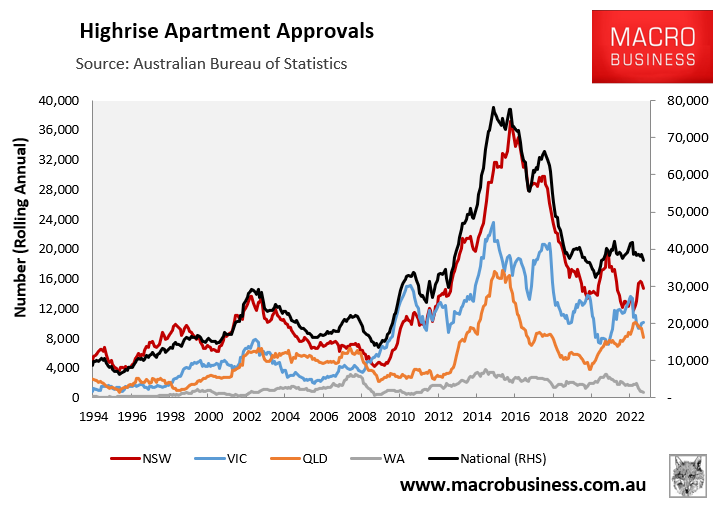The 2010s decade witnessed the largest boom in high-rise apartment construction in Australia’s history, concentrated in the nation’s major capital cities:

This unprecedented boom in high-rise apartment towers brought with it a corresponding surge in construction faults and quality problems, including cracking foundations, water leakages, balcony defects, and flammable cladding.
Notable examples include Opal and Mascot Towers in Sydney, which had to be evacuated after serious cracking was discovered.
These faults have cost owners as well as taxpayers millions in rectification costs.
Building construction lawyer, Bronwyn Weir, previously warned that “thousands and thousands of apartments have serious defects in their buildings”. She said the problem “is enormous”.
“We have what is now you know, a systemic failure that is quite difficult to unravel”.
“Some of these buildings could potentially be a write-off”, she said.
Engineer Leith Dawes likewise warned that buying an off-the-plan apartment in Australia had devolved into a game of “Russian roulette”, given the myriad of construction faults that are often unreported.
The Albanese government has embarked on a target to build 1.2 million homes over five years, or 240,000 homes a year for five consecutive years, most of which would comprise high density apartment towers in our major cities.
This level of construction would be greater than anything Australia has ever achieved before, given the record single year of new home construction was just 223,600 in 2017 during the afore mention faulty apartment construction boom:

Building regulation consultant, Bronwyn Weir, has warned that constructing so many apartments so quickly would likely result in compromised standards and another boom in faulty apartment towers.
“Australia’s chronically undersupplied housing market is heading for another development boom and apartments will lead the way”, wrote The AFR’s Michael Bleby.
“On current estimates, 50% of what will be built will have serious defects”, Weir told The AFR.
If Australia’s building sector does ramp-up apartment construction to meet the demands of the nation’s burgeoning population, we will inevitably experience similar outcomes to those of last decade.
Corners will be cut, quality will suffer, construction standards will deteriorate, and tens-of-thousands of low-quality high-rise apartments will be built across our major cities.

Instead of pursuing a high-rise slum future, the federal government should reduce immigration to a level compatible with the nation’s capacity to supply high-quality housing and infrastructure, as well as the carrying capacity of the natural environment (including water resources).
Lower, sustainable immigration (demand) would encourage the building industry to focus on quality over quantity in terms of construction, as well as ease the nation’s rental crisis.
Last decade’s high-rise apartment boom was an unmitigated disaster to which buyers and taxpayers are still paying the price.
Why repeat the same mistakes again by forcing rapid rates of construction to meet rapacious immigration-driven population growth?

